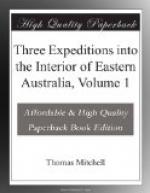I found the course much more to the southward than I had expected or wished. The stream separated into branches which re-united, and the channel was besides crossed in many places by large trees reaching from bank to bank. After passing close by several southerly bends in following a bearing of 20 degrees south of west, I met the river crossing that line at rightangles. This was at a distance of 7 1/2 miles from the camp, and near the point where the water broke over a rock of ferruginous sandstone, interspersed with veins of soft white clay. The rock appeared to be stratified, and inclined to the north-east. At 4 1/2 miles further we again made the river on a bearing of south 10 degrees west after crossing a small plain and passing through a scrub of tea-tree (or mimosa). Two miles beyond that part of the river we crossed the junction of a chain of ponds with it; and in proceeding on a bearing of 30 degrees east of south we crossed, when about two miles from that junction, another chain of ponds, apparently that on which we had encamped on the 22nd of January.
After riding about four miles beyond these ponds, according to the windings of the river, but chiefly towards the south, we encamped on a high point overlooking the stream, and where the grass was good. We here caught a large cod-perch, this being by far the best of the three kinds hitherto found by us. Latitude observed 29 degrees 12 minutes 3 seconds South.
February 3.
The course of the river compelled me to travel still further southward, which direction I accordingly pursued for seventeen miles, occasionally taking slight turns south-eastward, in order to avoid either the bends of the river, or hollows containing lagoons. One of these, which we arrived at after travelling about thirteen miles, was a very extensive sheet of water, a pleasing sight to us, still remembering how recently and frequently we had sought that life-sustaining element in vain. This latter had firm banks resembling the ancient channel of a river, although the bed was evidently much higher than the water flowing in the channel we were then exploring; and it was further remarkable in being contracted at one part by masses of a very hard rock consisting of grains and small pebbles of quartz cemented in a hard ferruginous matrix, probably felspar.
FORMIDABLE INSECTS.
At seventeen miles we entered a plain where grew trees of the Acacia pendula, and we traversed it in the most elongated direction or to the south-west. On entering the wood beyond a sudden, extreme pain in my thigh made me shout before I was aware of the cause. A large insect had fastened upon me, and on looking back I perceived Souter, The Doctor, defending himself from several insects of the same kind.* He told me that I had passed near a tree from which their nest was suspended; and it appeared that this had been sufficient to provoke the attack of these saucy insects, who were provided with the largest stings I had ever seen. The pain I felt was extreme, and the effect so permanent that when I alighted in the evening from my horse on that leg, not thinking of the circumstance, I fell to the ground, the muscles having been generally affected. The wound was marked by a blue circular spot as large as a sixpence for several months.




